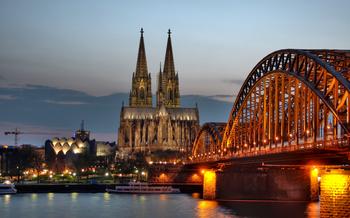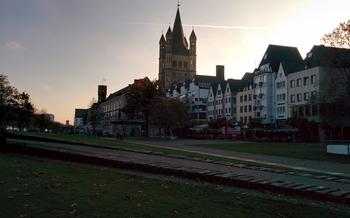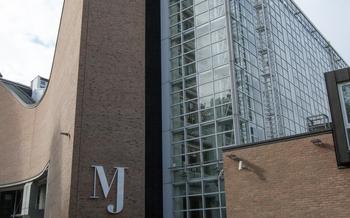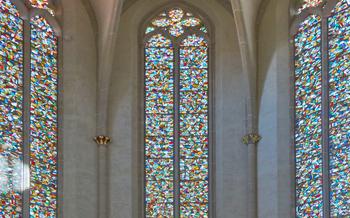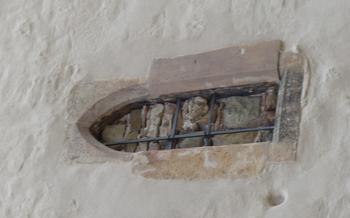
Stolperstein Stones Path
- What are Stolpersteine Stones?
- The Artist Gunter Demnig
- Locations of the Stolpersteine Stones
- Interactive Map and Guide
- Educational Value
- Local Initiatives and Involvement
- Emotional Impact
- Holocaust Memorial Sites
- Walking Tour Recommendations
- QR Codes and Additional Information
- Reflections on the Past and Present
- Insider Tip: A Hidden Gem
What are Stolpersteine Stones?
Stolpersteine, also known as "stumbling stones", are small, square concrete blocks measuring 10x10 centimeters that are embedded into the sidewalk in front of the last known address of victims of Nazi persecution. Each stone features a brass plate engraved with the victim's name, date of birth, date of deportation, and fate, if known.
The Stolpersteine project, initiated by German artist Gunter Demnig, serves as a decentralized memorial that aims to commemorate the victims of the Holocaust and other forms of Nazi persecution. The stones are installed in public spaces, often in front of the victims' former homes, schools, or workplaces, creating a powerful and poignant reminder of the individuals who were forcibly removed from their communities.
By placing the Stolpersteine at the victims' last known addresses, the project not only personalizes the victims' stories but also encourages passersby to pause, reflect, and remember the lives that were tragically cut short by Nazi tyranny. The stones serve as a tangible connection to the past, reminding us of the devastating consequences of intolerance and hatred.
The Artist Gunter Demnig
Gunter Demnig, a German artist born in 1947, is the visionary behind the Stolpersteine project. His artistic journey began with a profound realization while working on a construction site in Cologne in 199As he paved a sidewalk, he noticed a cobblestone that had been removed to make way for a new building. This seemingly insignificant event sparked a profound thought: what if, instead of discarding these stones, they could be used to commemorate the victims of the Holocaust?
This idea evolved into the Stolpersteine project. Demnig's artistic vision was to create a decentralized memorial, a poignant reminder of the individuals who were forcibly removed from their homes and communities during the Nazi regime. These small, brass-plated cobblestones, each bearing the name and life dates of a victim, would serve as a permanent reminder of their existence and the atrocities they endured.
With unwavering dedication, Demnig has personally installed over 96,000 Stolpersteine in cities and towns across Europe, perpetuating the memory of those who were systematically targeted and exterminated. His artistic intervention has transformed the urban landscape into a powerful and evocative memorial, ensuring that the victims of the Holocaust are never forgotten.
Locations of the Stolpersteine Stones
The Stolpersteine stones in Essen can be found in various neighborhoods and streets throughout the city. Some of the most notable locations include:
-
The Rüttenscheider Straße, a vibrant shopping street, features a significant number of Stolpersteine stones, commemorating individuals who once lived and worked in this bustling neighborhood.
-
The Essen-Werden district, with its charming historical center, is home to several Stolpersteine stones, offering a glimpse into the lives of those affected by the Nazi regime in this picturesque part of the city.
-
The Altenessen district, once a working-class area, holds poignant reminders of the past through its Stolpersteine stones, shedding light on the experiences of ordinary people during a tumultuous period in history.
-
The Essen-Bredeney district, with its tranquil parks and stately homes, also features Stolpersteine stones, serving as a reminder that the impact of the Nazi era extended to all corners of the city.
Exploring these different locations provides a comprehensive understanding of the widespread impact of the Nazi regime on the lives of Essen's citizens.
Interactive Map and Guide
To enhance your exploration of Essen's Stolpersteine stones, consider using an interactive map or guide. Several resources are available online, allowing you to conveniently locate and navigate the memorial plaques throughout the city. These maps often provide detailed information about each stone, including the names, life stories, and historical context of the individuals commemorated.
For a more immersive experience, consider participating in a guided tour. Professional guides can offer insights into the history of the Nazi era in Essen and the significance of the Stolpersteine project. They can also share personal anecdotes and stories related to the individuals memorialized.
If you prefer a self-guided exploration, you can use the interactive map to plan your own route. Start by identifying the neighborhoods or streets with the highest concentration of Stolpersteine stones. You can then explore these areas at your own pace, taking the time to read the inscriptions and reflect on the lives of those remembered.
Educational Value
The Stolpersteine project serves as a powerful educational tool, fostering remembrance and understanding of the Holocaust. By encountering these small memorials, individuals are prompted to reflect on the lives and fates of those who were persecuted and murdered by the Nazi regime. The stones act as tangible reminders of the victims, shedding light on their identities, stories, and the atrocities they endured.
Through the Stolpersteine project, history is brought to life, allowing individuals to connect with the past in a personal and meaningful way. The stones encourage critical thinking and promote dialogue about the Holocaust, its causes, and its consequences. By raising awareness and educating the public, the project contributes to the preservation of historical memory and helps prevent such atrocities from happening again.
In addition to their educational value, the Stolpersteine stones also serve as a reminder of the importance of tolerance, empathy, and respect for human rights. They challenge us to confront the dark chapters of history and to work towards a more just and equitable society, where every individual is valued and respected.
Local Initiatives and Involvement
Various local initiatives and organizations in Essen are dedicated to preserving and maintaining the Stolpersteine stones. These groups recognize the importance of keeping the memory of the victims alive and ensuring that their stories are not forgotten.
One notable initiative is the "Stolpersteine Essen e.V." association. This non-profit organization works to research the lives of the individuals commemorated by the stones, collect historical information, and organize educational events. They also actively support the installation of new Stolpersteine stones and promote awareness of the project.
Another important initiative is the "Arbeitskreis Stolpersteine Essen" (Working Group Stolpersteine Essen). This group consists of volunteers who assist in cleaning and maintaining the Stolpersteine stones, ensuring their visibility and preservation. They also conduct guided tours and educational programs to raise awareness about the victims and the Stolpersteine project.
By supporting these local initiatives, visitors and residents can contribute to the preservation of this important memorial project. Donations, volunteering, and participation in educational events are all ways to actively engage with the Stolpersteine stones and honor the memory of the victims they represent.
Emotional Impact
Encountering the Stolpersteine stones evokes a profound emotional response. These small, unassuming memorials serve as powerful reminders of the individual lives lost during the Holocaust. As you walk along the streets of Essen and come across these stones, it is impossible not to be moved by their simplicity and the stories they represent.
The names inscribed on the stones, often accompanied by brief biographical information, bring a human face to the statistics of the Holocaust. You may find yourself pausing to read the stories of those who once lived in the very building you are standing in front of. Their hopes, dreams, and tragic fates become tangible, creating a deeply personal connection to the past.
The Stolpersteine stones are not merely memorials to the victims of the Holocaust; they are also a testament to the resilience and strength of the human spirit. They stand as a reminder that even in the darkest of times, individuality and humanity can prevail. By acknowledging and remembering these individuals, we honor their lives and ensure that their stories are never forgotten.
Holocaust Memorial Sites
Complementing the Stolpersteine stones, Essen is home to several Holocaust memorial sites that offer a deeper understanding of the city's history during the Nazi era. The Old Synagogue, located in the city center, serves as a poignant reminder of the vibrant Jewish community that once thrived in Essen. Its striking architecture and interactive exhibits narrate the history of the synagogue and the persecution faced by the Jewish population.
Another significant memorial site is the Gedenkstätte Alte Synagoge, housed in the former Jewish school building. This memorial features a moving exhibition dedicated to the victims of the Holocaust from Essen and the surrounding region. Through personal stories, artifacts, and historical documents, visitors gain insights into the lives and fates of those who were affected by the Nazi regime.
By visiting these memorial sites in conjunction with the Stolpersteine stones, visitors can gain a comprehensive understanding of Essen's history and the impact of the Holocaust on its citizens. These sites serve as powerful reminders of the atrocities committed during this dark period and contribute to the ongoing work of remembrance and education.
Walking Tour Recommendations
To fully appreciate the impact of the Stolpersteine stones and the stories they represent, consider embarking on a self-guided walking tour. Plan your route carefully, ensuring you cover areas with a significant concentration of stones. Research specific addresses or neighborhoods associated with the individuals you wish to commemorate.
As you navigate the city, keep an attentive eye on the sidewalks and pavements. The Stolpersteine stones are often discreet, blending seamlessly into the urban landscape. Their unassuming presence demands a mindful approach. Take your time, pause to read the inscriptions, and reflect on the lives they honor.
Consider starting your tour in the Rüttenscheid district, where you'll find a cluster of Stolpersteine stones commemorating Jewish families who once called this vibrant neighborhood home. From there, proceed towards the city center, exploring the Gerichtsviertel and Innenstadt districts. These areas hold a wealth of Stolpersteine stones, each telling a unique story of persecution and resilience.
Remember, this journey is not merely about sightseeing; it's a profound act of remembrance. As you walk, let the stories of these individuals resonate within you. Reflect on their struggles, their hopes, and their tragic fates. Allow their memory to serve as a reminder of the horrors of the past and the importance of standing up against intolerance and hatred in all its forms.
QR Codes and Additional Information
Some of the Stolpersteine stones in Essen feature QR codes that provide access to additional information about the individuals they commemorate. Using a smartphone, visitors can scan these codes to learn more about the lives, stories, and fates of those who were persecuted and murdered by the Nazi regime. This digital element enhances the interactive experience and allows visitors to delve deeper into the history behind each stone. By incorporating QR codes, the Stolpersteine project embraces technology to connect the past with the present and provide a more comprehensive understanding of the victims' lives.
Reflections on the Past and Present
The Stolpersteine stones serve as a powerful reminder of the atrocities committed during the Holocaust and the importance of learning from the past. They challenge us to confront the dark chapters of history and to never forget the victims of Nazi persecution. By shedding light on individual stories and preserving their memory, the Stolpersteine project contributes to a deeper understanding of the Holocaust and its devastating impact on communities across Europe.
In today's world, where hatred, intolerance, and discrimination still persist, the Stolpersteine stones hold even greater significance. They remind us of the fragility of human rights and the urgent need to combat all forms of extremism and prejudice. By acknowledging and confronting the past, we can work towards building a more just and inclusive society where such atrocities never happen again.
The Stolpersteine stones are not just memorials to the victims of the Holocaust; they are also symbols of hope and resilience. They represent the collective effort to keep the memory of those who were lost alive and to ensure that their stories are never forgotten. By visiting these stones and reflecting on their significance, we can honor the victims, promote understanding, and work towards a future free from hatred and violence.
Insider Tip: A Hidden Gem
In the heart of Essen's vibrant Rüttenscheid district, nestled between trendy cafes and boutiques, lies a hidden gem among the Stolpersteine stones. Look for the inconspicuous cobblestone at Rüttenscheider Straße 55, commemorating the life of Else Hirsch. Else, a talented pianist and composer, was forced to flee Nazi Germany in 1938, leaving behind her beloved Steinway grand piano. Remarkably, the piano survived the war and was eventually returned to Else's family. Today, it stands as a symbol of resilience and the enduring power of music in the face of adversity. Discover this hidden gem and let the story of Else Hirsch transport you back in time, reminding you of the strength and courage of those who resisted oppression.
